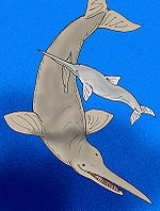
Eurhinodelphis
Encyclopedia
Eurhinodelphis is an extinct genus of Miocene
cetacean. Its fossils have been found in France
, Belgium
, Maryland
and California
.
 Eurhinodelphis was around 2 metres (6.6 ft) in length. In most respects, it would have looked like a modern dolphin
Eurhinodelphis was around 2 metres (6.6 ft) in length. In most respects, it would have looked like a modern dolphin
or porpoise
, but its upper jaw was elongated into a sharp tip similar to that of a swordfish
. Most likely, Eurhinodelphis used it in a similar manner to swordfish, hitting or stabbing prey. It also had long, sharp teeth.
Compared with earlier fossil species, Eurhinodelphis had complex ears, suggesting that it already hunted by echolocation
like modern whales. Its brain was also asymmetrical, a trait found in modern dolphins, and possibly associated with the complexities of navigating its environment.
Eurhinodelphis was closely related to the orca
-sized Macrodelphinus
.
on 17 December, 1867. O. Abel studied and illustrated the European species in a series of articles published in 1901, 1902 and 1905; subsequently, fossil skulls found in the Calvert Formation in Maryland and Virginia could be attributed to this genus.
Miocene
The Miocene is a geological epoch of the Neogene Period and extends from about . The Miocene was named by Sir Charles Lyell. Its name comes from the Greek words and and means "less recent" because it has 18% fewer modern sea invertebrates than the Pliocene. The Miocene follows the Oligocene...
cetacean. Its fossils have been found in France
France
The French Republic , The French Republic , The French Republic , (commonly known as France , is a unitary semi-presidential republic in Western Europe with several overseas territories and islands located on other continents and in the Indian, Pacific, and Atlantic oceans. Metropolitan France...
, Belgium
Belgium
Belgium , officially the Kingdom of Belgium, is a federal state in Western Europe. It is a founding member of the European Union and hosts the EU's headquarters, and those of several other major international organisations such as NATO.Belgium is also a member of, or affiliated to, many...
, Maryland
Maryland
Maryland is a U.S. state located in the Mid Atlantic region of the United States, bordering Virginia, West Virginia, and the District of Columbia to its south and west; Pennsylvania to its north; and Delaware to its east...
and California
California
California is a state located on the West Coast of the United States. It is by far the most populous U.S. state, and the third-largest by land area...
.
Description

Dolphin
Dolphins are marine mammals that are closely related to whales and porpoises. There are almost forty species of dolphin in 17 genera. They vary in size from and , up to and . They are found worldwide, mostly in the shallower seas of the continental shelves, and are carnivores, mostly eating...
or porpoise
Porpoise
Porpoises are small cetaceans of the family Phocoenidae; they are related to whales and dolphins. They are distinct from dolphins, although the word "porpoise" has been used to refer to any small dolphin, especially by sailors and fishermen...
, but its upper jaw was elongated into a sharp tip similar to that of a swordfish
Swordfish
Swordfish , also known as broadbill in some countries, are large, highly migratory, predatory fish characterized by a long, flat bill. They are a popular sport fish of the billfish category, though elusive. Swordfish are elongated, round-bodied, and lose all teeth and scales by adulthood...
. Most likely, Eurhinodelphis used it in a similar manner to swordfish, hitting or stabbing prey. It also had long, sharp teeth.
Compared with earlier fossil species, Eurhinodelphis had complex ears, suggesting that it already hunted by echolocation
Animal echolocation
Echolocation, also called biosonar, is the biological sonar used by several kinds of animals.Echolocating animals emit calls out to the environment and listen to the echoes of those calls that return from various objects near them. They use these echoes to locate and identify the objects...
like modern whales. Its brain was also asymmetrical, a trait found in modern dolphins, and possibly associated with the complexities of navigating its environment.
Eurhinodelphis was closely related to the orca
Orca
The killer whale , commonly referred to as the orca, and less commonly as the blackfish, is a toothed whale belonging to the oceanic dolphin family. Killer whales are found in all oceans, from the frigid Arctic and Antarctic regions to tropical seas...
-sized Macrodelphinus
Macrodelphinus
Macrodelphinus kelloggi was an orca-sized relative of the cetacean Eurhinodelphis. It lived off the coast of what is now California during the early Miocene. Because of its size, and inch-long teeth, it is believed to have been an apex predator. Macrodelphinus is known from a fragmentary skull...
.
History
Eurhinodelphis was first described by B. Du Bus in a paper read before the Royal Academy of Sciences of BelgiumThe Royal Academies for Science and the Arts of Belgium
There are two Royal Academies for Science and the Arts in Belgium, corresponding to the two main languages of the country, Dutch and French . The Academies are located in the Palace of Academies in Brussels....
on 17 December, 1867. O. Abel studied and illustrated the European species in a series of articles published in 1901, 1902 and 1905; subsequently, fossil skulls found in the Calvert Formation in Maryland and Virginia could be attributed to this genus.

